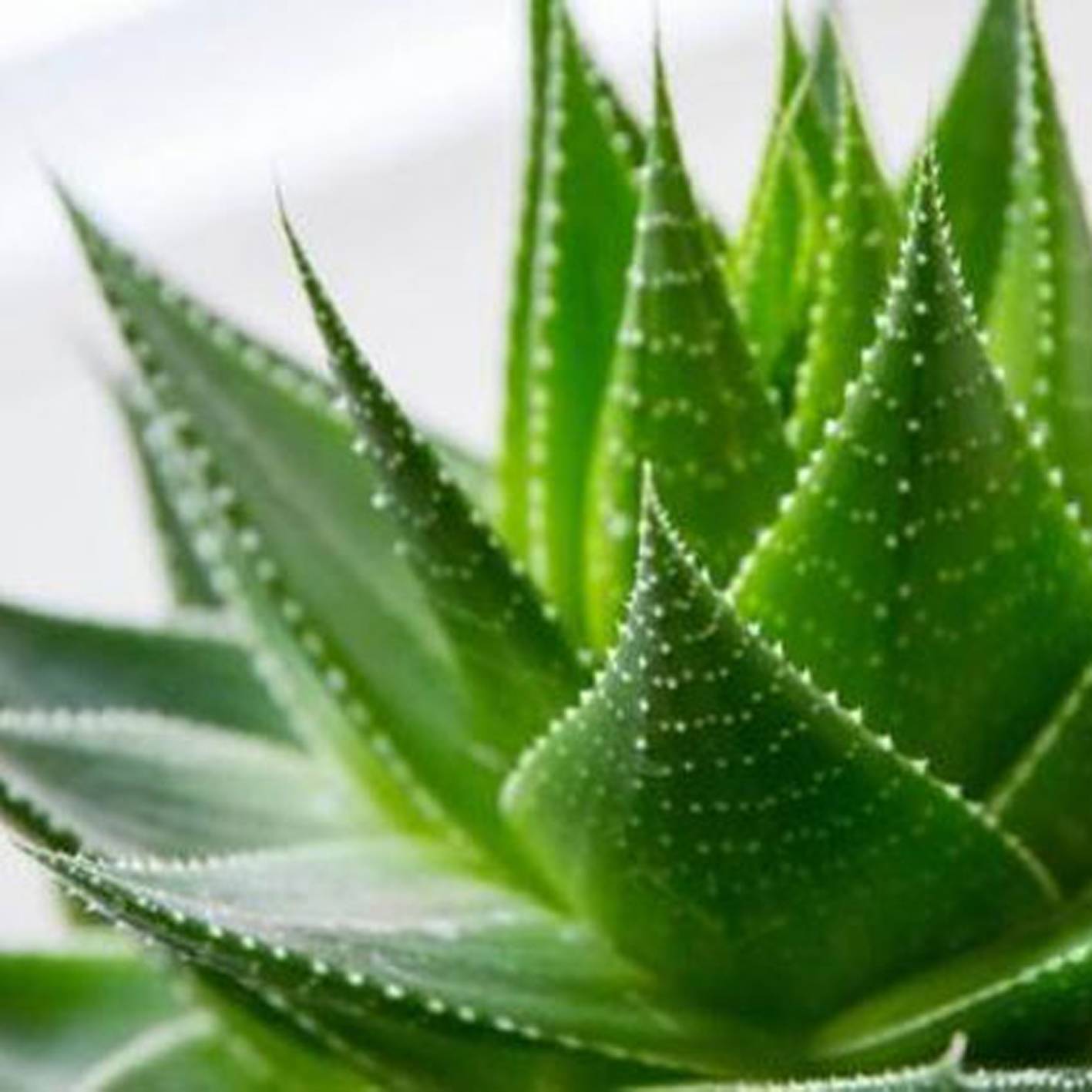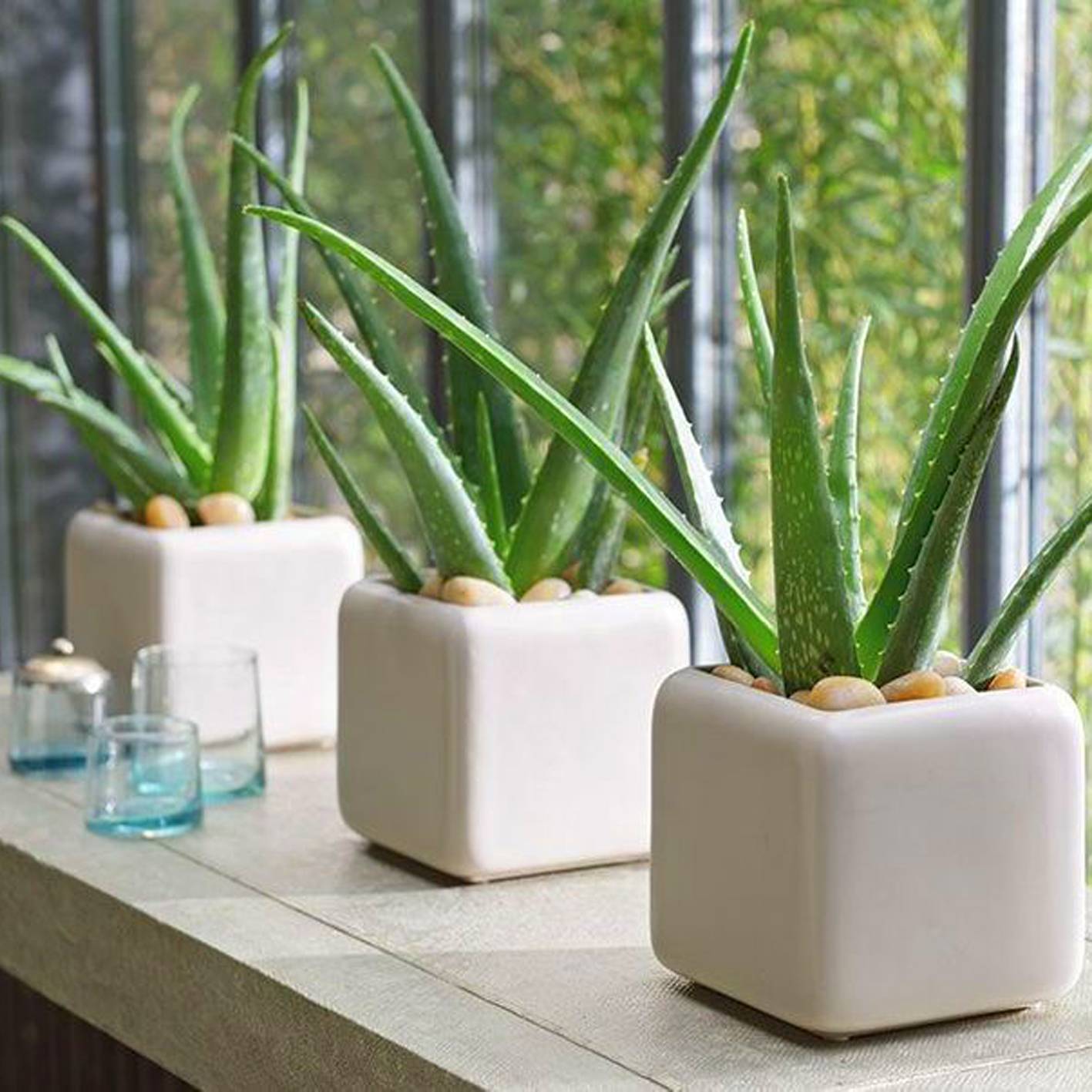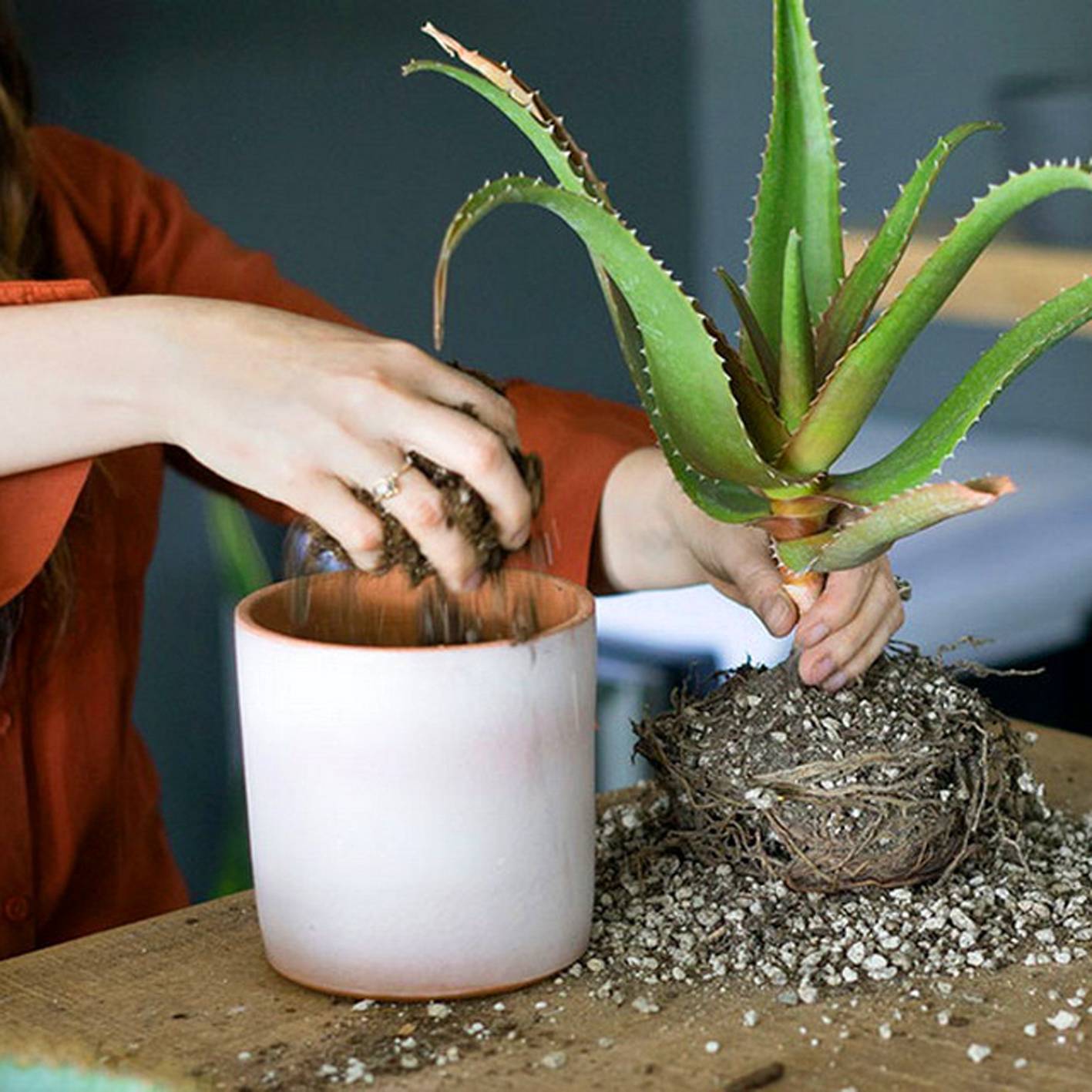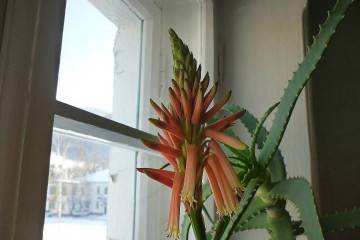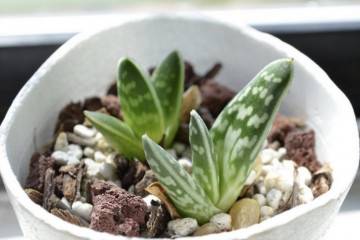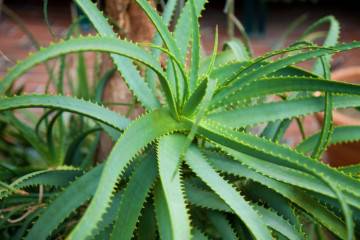Aloe flower - what it looks like, types and care
Content:
Aloe is a medicinal flower with antibacterial and healing effects. It looks like a shrub with fleshy leaf plates that form from a root system that resembles a rosette. It reaches a height of 0.5-5 m. The branches have a serrated border and a pimpled structure. When a leaf breaks, a nutritious sap is released, which contains the entire value of the plant.
General description of plants of the genus aloe
There are more than 400 similar species in the genus represented. Africa is considered to be the homeland. The perennial flower has medicinal properties. Unpretentious to the soil, as it can continue to exist even on volcanic ash. For medicinal purposes, they are grown in special reserves. The bush flower belongs to the Xantorrhea family and has many branches. Lanceolate leaves reach a length of 50 cm. In nature, there are many shades: from light green to reddish.
Aloe varieties
A large variety of a flower allows it to be used not only for medical, but also for decorative purposes. The height of some representatives reaches 15 m. Characteristics and care features depend on the homeland of the flower and do not affect the uniqueness of the variety. This is a popular houseplant.
The healing properties of aloe have been in demand since ancient times. The Egyptian priests used the juice as a rejuvenating agent. This is confirmed by the bouquet of vitamins present in it:
- beta carotene;
- vitamins of group A and B;
- amino acids;
- polysaccharides;
- magnesium;
- iron;
- manganese.
This is an incomplete list of nutrients that have a beneficial effect on the human body. A home flower can also provide many benefits due to its phytoncide enrichment function.
Decorative views
The plant has received many names among the people: real aloe, agave, aloe vera. There are 15 known varieties used for medicinal purposes.
Common types of aloe:
- variegated. Known by other names: spotted, striped, or brindle. This succulent is used in landscape decoration. It reaches 30 cm. The stem is shortened, the leaves are triangular. The two-tone color influenced the name of the flower. In the spring, you can see bright orange flowers coming out of the leaves;
- squat. Place of origin - Africa. It is a perennial plant that has a thorn-shaped edging and several shades: gray-green and green-blue. A special feature is the red flowers that cover the entire plant;
- cap-shaped. This subspecies reaches 2 m in height and has protection on the leaves in the form of thorns and denticles. Its scarlet flowers are saturated with a pleasant aroma.
Medicinal species
Medicinal species are grown more willingly by novice growers. Wound healing and bactericidal qualities help fight colds and viral diseases.
The healing properties of aloe:
- removal of toxins and toxins from the body;
- increased tone;
- restoration of intestinal microflora;
- enhancing growth and preventing hair loss;
- improved blood circulation;
- removal of various pains;
- use for the treatment of female diseases.
The medicinal varieties of aloe include:
- aloe vera. A well-known flower. The second name is Barbados aloe. Grown since ancient times. The short stem is light green in color. Leaves with a diameter of 60 cm gather on the top of the head. The delicate structure is protected by thorns. Aloe vera is not often seen on windowsills due to its unkempt appearance. Widespread in medicine and cosmetology. Restores the skin. Has a rejuvenating effect;
- aloe tree-like. No less popular in Russia. It has rightfully taken its place of honor on many windowsills of apartments and offices. The people called him the agave because of the peculiarity of blooming 1 time in 100 years. Aloe tree is a home flower. It reaches 5 m in height in the wild and only 60 cm at home. The upright tree strips its lower part over the years. The formed scars at the base of the rosette are used for vegetative reproduction. The wax bloom of the flower affects the bluish color of the lanceolate-linear leaves. The special coating reduces evaporation. Protective thorns are located along the edges of the leaves. Flowers in the form of bells reach 40 cm in diameter. In indoor conditions, the plant practically does not bloom. The recommended rest mode occurs at a temperature of 14 ° C and below;
- aloe soap. A perennial species that has short-stemmed shoots. The edges of the dark green leaves are protected by brown thorns. Red-yellow leaves are observed once a year.
What are the most common types of home maintenance
Aloe is a flower that is unpretentious. 200 varieties can be grown at home. The most common of this species is the spinous aloe (Aristata). The unusual shape of the hemisphere is formed by the growth of leaves. They have a speck of white and orange flowers.
Other interesting species are described below.
- Intimidating. The numerous thorns flanking the leaves give the flower its name. At home, it grows up to 3 m. Green and pale red leaves are located on a high stem. The variety has pharmaceutical properties.
- Marlot. This type of aloe is capable of forming 4-meter thickets, but only in its natural environment. In indoor conditions, its size is half the size. The leaves are thick and fleshy, silvery-blue in color. Red-brown teeth along the edges. The whole bush is assembled into an outlet. In the peduncle, you can see yellow and orange flowers.
- Hawortia-like. The shrub is oblong with pale green leaves. Distinctive barbs cover the edges. During flowering, red buds can be observed, which bloom only with proper care. The flower reaches a height of 30 cm.
You can learn how to care for aloe by reading some recommendations.
How to care for aloe succulents at home
Care for all types of flowers is almost the same. It is important to observe timely watering, top dressing and other factors that affect the positive development of the plant.
Illumination and temperature conditions
For aloe, as well as for other thermophilic plants, it is very important to be under good light.It is recommended to place succulents on a windowsill on the sunny side. With a lack of light, the leaves bend. The presence of lamps is not necessary, natural light will do.
The room temperature is sufficient for the intensive growth of the flower. Withstands from 12 ° C to 30 ° C. In the summer season, the pots are displayed on the balcony or veranda. The season dictates the time and amount of watering.
Watering rules and humidity
In the summer, watering is frequent and abundant. In winter, you need to wait until the substrate is completely dry. The water should be at room temperature.
In the summer season, the frequency of watering is 1-2 times a week, in winter - once every 3-4 weeks. All aloe are afraid of overflow. The accumulation of water leads to rotting of the root system and rosette.
Special attention should be paid to spraying the aloe and how to care for it. It can also cause increased moisture between the sheets. The sprayer should be located 30 cm from the bush.
Top dressing and soil quality
Top dressing is carried out during the breeding and flowering period - in April and September. For this, complex fertilizers are used. For the intensive growth of aloe, you need:
- good soil;
- high-quality feeding.
The finished substrate can be purchased at a specialist store. Its composition fully meets the necessary requirements.
You can also cook it yourself from:
- 2 parts of sod land;
- 1 part leaf humus and sand;
- charcoal;
- peat;
- expanded clay.
Flower container size
For the beneficial development of the flower, it is better to use voluminous flowerpots. The transplant is carried out every 2 years, increasing the size of the pot by 1-2 cm.
Flowering and dormant period
In the wild, succulents bloom regularly - 2 times a year. The first flowering occurs in the spring, the second in the fall. They emit a spike-shaped inflorescence that blooms in different directions from the arrow. One succulent has 1 arrow. The palette of inflorescences ranges from orange to pink tones.
In their natural habitat, succulents develop better, and flowering occurs more beautifully. In apartment conditions, it is not always possible to admire this process.
A dormant period is required for the active growth of the bush. It is carried out from the end of summer as follows: watering is reduced and the air temperature is lowered to 10 ° C. The air must remain dry throughout the winter.
Growing problems, diseases and pests
Aloe is an unpretentious and perennial plant. Difficulties in growing should not arise.
Problems affecting flower growth:
- excess moisture. Promotes pallor and wilting. The stems become elongated;
- lack of moisture. Leaves wrinkle and turn red;
- poisoning with chemicals. Yellowed leaves symbolize chlorinated water, the ingress of tobacco smoke, low potassium content in the soil;
- heavy and clayey ground. Such a substrate does not conduct air well. In response to the reaction, a yellow color of the plant is observed;
- dry rot. Root decay occurs imperceptibly. Caused by heavy or cold watering. The stem stops developing and the flower dries up. To save the aloe, they are planted, the affected areas are removed and sprinkled with sulfur, ash and coal powder. Then they are transplanted into new soil. This insidious disease is the most common. In order to avoid it, constant preventive treatment with a fungicide is recommended.
In addition to diseases, aloe can suffer from attacks of pests that cause disastrous damage.
- Mealy worm. The most dangerous pest.It is removed mechanically with a brush or tweezers. Further, the infected area is treated with garlic tincture or insecticides.
- Shield. These insects have a shield-like shell. Stable, difficult to remove mechanically. In the fight, chemicals are used.
- Spider mite. Blocks the respiratory processes of the plant. It does great harm. You can remove it with damp gauze or soapy water. Garlic tincture and acaricides are also used.
- Thrips. An annoying pest that has the ability to develop immunity to chemicals used to combat it. Prevention in the form of spraying with insecticides, as well as nutrition of the soil with minerals is the best way to fight the parasite. After the destruction of an adult, the procedure is repeated after a couple of weeks. This will rid the flower of any remaining larvae.
- Microscopic worms. They affect the root system. They block nerve endings and prevent further development. It is recommended to remove the affected areas completely.
Do not disturb the succulent by moving it from place to place. This makes him uncomfortable. Adequate sunshine and air is what he needs. Considering all the tips and tricks, you can preserve the health and beauty of the flower for many years.
